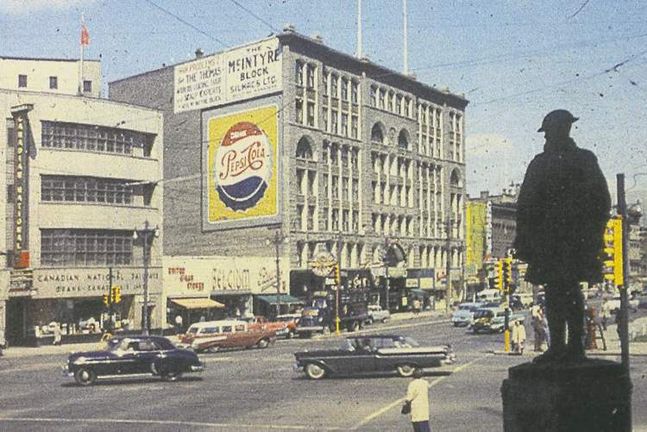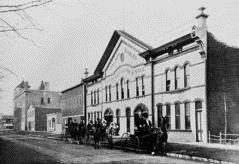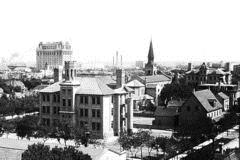
The McIntyre Block pictured during the 1950s. It was the first office building in Western Canada, and site owner Creswin reportedly is eyeing a hotel tower for the land.
The Archives of Manitoba are filled with photos of buildings, but there are none of parking lots. Urbanites hate them. Mayors and premiers campaign against them. Parking lots are a maligned group. It is easy to love a building, to find beauty and meaning in stone columns and arched windows, but nobody ever considers the story of a parking lot or wonders what ghosts might linger on their asphalt surfaces.

The Palace Livery and Stables locale could end up home to the city's highest tower. (ARCHIVES OF MANITOBA)

Carleton School in 1918. So/Po Square is slated to rise on the lot there. (ARCHIVES OF MANITOBA)
Winnipeg's parking lots define the downtown as much as the towers rising at its core. The neighbourhood between Portage Avenue and Broadway is a particularly fractured urban landscape. Ever wonder why?
The story of how that area became home to so much surface parking is a journey that began 143 years ago when the Hudson's Bay Co. surrendered Rupert's Land to Canada. In the transfer, the company maintained ownership of Upper Fort Garry and 500 acres of adjacent land. This reserve was unsettled prairie in an area defined today by the two rivers, Portage and Main to the north and Memorial Boulevard to the west.
To maximize profit on their property, HBC laid out the very regular grid of streets that we see in the area today and held public auctions to sell the lots. The aggressive entrepreneurs of the young city didn't like HBC's rules or inflated prices and reacted by locating the commercial centre outside of the reserve around what is the Exchange District today. With the city's more substantial buildings happening north of the Portage Trail (Avenue), the reserve land grew slowly, becoming an upscale residential neighbourhood filled with single-family homes and terrace row housing.
Fast-forward to the postwar boom of the 1950s. As developers made way for new modernist buildings, they naturally avoided the masonry structures of the Exchange, instead looking toward these blocks south of Portage Avenue filled with less permanent, wood-framed residential properties. To accommodate parking, inexpensive, easy-to-clear residential lots were snapped up and the buildings demolished, leaving the legacy of large parking lots that define the neighbourhood's character today.
The economics of Winnipeg's downtown and the growth of its residential population are finally starting to make privately funded redevelopment of these parking lots an attractive option. Recent announcements give hope we will soon see grand-scale private projects rising on three of the largest, oldest and most prominent surface lots in our city.
As these parking lots embark on their transformation into celebrated new developments, we might reflect on their contribution to our city's historic narrative. What do they have to say? What role have they played in our history? The following is an investigation into the stories each of these three lots are able to tell.
Lot 1: Graham Avenue between Carlton and Hargrave streets, west of Cityplace.
After its initial failure to sell commercial lots on their reserve, HBC decided to donate land for schools and churches to make their property more attractive to residential buyers. In 1880, six parcels were given to the construction of St. Mary's Cathedral and Carlton School, the site of today's parking lot.
Designed by Barber and Barber, the architects of the old gingerbread city hall, the Carlton was the second large school in the city. Its scale and grandeur would attract Daniel McIntyre from New Brunswick to be its principal. For 43 years, he was the superintendent of schools and is considered the father of Winnipeg's school system, establishing a modern curriculum, educational standards and administration structure. He arrived when there were 49 teachers in Winnipeg and retired in charge of more than 1,000.
The school eventually closed, and in 1930, the T. Eaton Company purchased the site and demolished the building to establish one of Winnipeg's first large-scale commercial parking lots. At 83 years, it is the oldest major surface lot in the city. For 30 years, an area of the property was shrewdly leased to the Union Bus Depot, ensuring all new arrivals to the city would find their way to the big store first.
Current proposal: The Longboat Development Corporation is currently planning a mixed-use project called So/Po Square, potentially with three small towers surrounding a sports-themed outdoor plaza.
Lot 2: Graham Avenue between Smith and Garry streets, north of the former post office.
This giant parking lot was once home to the Palace Livery and Stables. The facility was a base for horse-drawn taxicabs in Winnipeg's early years. In 1912, it would succumb to changing times and be redeveloped as the Palace Garage, selling and repairing vehicles driven by a new kind of horsepower.
In 1914, the Winnipeg Tribune would relocate from Newspaper Row in the Exchange to a new home beside the Palace Garage. Designed by J.D. Atchison, the city's most prominent architect, the building had an ornate facade characterized by 14 unique gargoyles hanging over the sidewalk. Each was dressed in medieval clothing and represented a different profession in the newspaper trade.
In 1969, the statues were removed and given away as part of a harsh 'modernization' of the old building. Recently, one gargoyle found its way to the Manitoba Museum, who then discovered one of its mates among their two million artifacts. The museum is hoping other private owners will come forward and the collection will be made into an exhibit.
When the Tribune suddenly shut its doors in 1980, the building fell silent. Three years later, after a failed attempt to convert it to residential use, the Tribune Building and Palace Garage, which the newspaper had taken over in the 1950s, was demolished to make way for parking. A twin-tower proposal by the Lions Club surfaced in 1994 and another in 2002, but both failed, leaving the site as one of the largest surface lots in the city for 30 years.
Current proposal: In a whirlwind of publicity, Toronto Developers Fortress Real Developments Inc. breezed into town last month to celebrate their intentions to redevelop the site into an iconic mixed-use project that might include the tallest tower in the city and a long-sought-after grocery store.
Lot 3: Portage and Main, north of the former TD tower.
In 1870, Alexander McIntyre made the journey from southern Ontario to Winnipeg as part of the Wolseley Expedition to quell Louis Riel and the Red River Rebellion. In exchange for his military service, he received 160 acres of farmland. A shrewd businessman, McIntyre leveraged that into a property at the heart of the new village. In a small gable-roofed building right out of a spaghetti western, he would open the White Saloon on Winnipeg's Main Street. In 1882, the building would catch fire, his stock of wholesale liquors providing the fuel for numerous explosions reported throughout the night.
After constructing a new building that would also soon go up in flames, he cleared the rubble and set upon building an edifice that would make his name a landmark in the city. In 1898, he would open the first office building in Western Canada, known to generations of Winnipeggers as the McIntyre Block. Its rustic limestone facade would stand as a familiar monument at the corner of Portage and Main for the next eight decades.
In the late 1970s, the announcement of the demolition of the McIntyre Block and other buildings in the area became a touchstone for public debate that would spawn Winnipeg's first heritage-preservation movement. The thought of a parking lot replacing the beloved McIntyre Block activated the city to create a new Historic Restoration Area (today the Exchange District) with design and preservation guidelines. The owners of the McIntyre Block, however, successfully lobbied the city to have their property excluded from that zone. They argued restoration would be prohibitive and promised the parking lot would soon be replaced by new construction as part of a complete redevelopment of the corner. The site has been a gravel parking lot beside our famous 'windy corner' ever since.
Current proposal: Property owners Creswin have announced they are performing structural investigations on site and are in the final leg of a development process. The Free Press's Bartley Kives reported a hotel tower is the likely tenant. An announcement would appear to be imminent.
Surface-parking lots are today recognized as the enemy of great cities, but if we take the time to listen, they are often able to tell an interesting story about their place. That being said, if Winnipeg's biggest parking lots do become shiny new buildings, good riddance to them.
Brent Bellamy is senior design architect for Number Ten Architectural Group.
bbellamy@numberten.com
Republished from the Winnipeg Free Press print edition June 10, 2013 B4